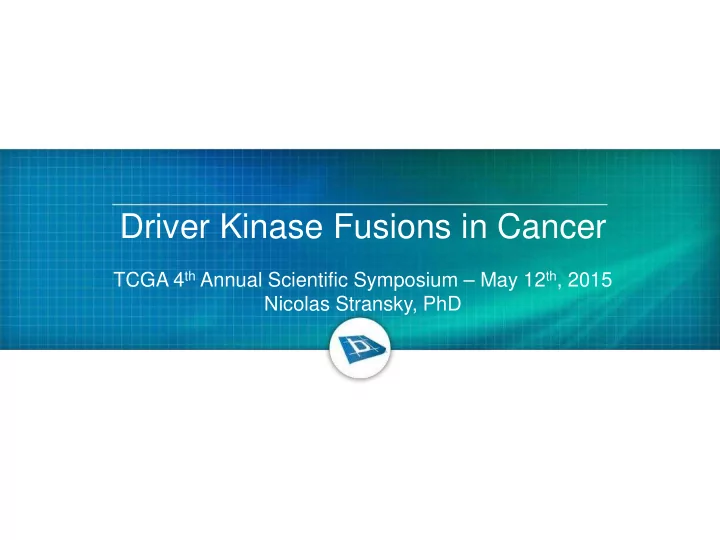

Driver Kinase Fusions in Cancer TCGA 4 th Annual Scientific Symposium – May 12 th , 2015 Nicolas Stransky, PhD
What are Kinase Fusions? KIF5B-RET Fusion Genomic instability, a hallmark of cancer, can result in chromosomal translocations or other complex rearrangements These events can produce chimeric genes called “fusions” Known driver kinase events include BCR-ABL1 in CML, EML4-ALK in Lung adenocarcinoma Ju Y S et al . Genome Res. 2012 2
May 2015: >10,000 RNAseq Samples in TCGA, 33 Tumor Types TCGA RNA-seq data for ~10,000 tumors Fusion finding algorithm First pan-cancer evaluation of fusions 3
Novel Algorithm for Rapid Kinase Gene Fusion Detection RNA-seq raw Optimized for sensitivity and reads speed Fast alignment Large speed improvement over public algorithms Aligned reads Real-time analysis of new data (bam) (TCGA, ICGC, Blueprint data) Fusion detection Chimeric read Gene Gene A fusions Gene B Isolation of supporting reads Split read Genomic evidence 4
Computational Pipeline for Fusion Detection Core algorithm Fusion Detection – Identifies gene-gene fusions in RNA-seq data – Reports supporting evidence for each fusion Post-processing – Heuristics to filter out passenger events Intergenic junctions (between two exons) Therapeutic Coding sequence in frame Post-processing Presence of kinase catalytic domain relevance – Heuristics to filter out false-positives Fusions present in normal Alignment artifacts (repetitive sequences) High expression level of one partner Reporting tools Report & – Reporting of pipeline outputs, fusion frequencies Annotate – Manually review and annotate fusions Stransky et al. Nature Communications, 2014 5
Pipeline output: kinase fusions after manual review 2.8 % of tumor samples contain a likely oncogenic kinase fusion (2.0 % excluding thyroid cancer) Thyroid cancer, sarcoma and glioblastoma have the highest proportion of recurrent kinase fusions Kidney clear cell and kidney chromophobe have almost no kinase fusions 6
Genomic evidence for novel kinase fusion events 7
The Landscape of Kinase Fusions in Cancer New Indications and New Gene Partners Novel Recurrent Kinase Fusions Adapted from Stransky et al. Nature Communications, 2014 8
Novel partners and novel indications for kinase fusions RET Known partners 9
Novel partners and novel indications for kinase fusions RET Novel Partners, all with dimerization motifs 10
Novel MET and PIK3CA Fusions MET and PIK3CA fusions occur in solid tumors where mutations and amplifications are already driver events MET fusions in kidney papillary cell carcinoma 11
Novel PIK3CA fusions – supporting reads PIK3CA
New WASF2-FGR 5’-UTR Fusions Src family kinase Highly expressed in some hematopoietic cells and malignancies Oncogenic potential - viral oncogene homolog A new promoter fusion not previously implicated in cancer 13
New WASF2-FGR 5’-UTR Fusions CANCER TYPE UNDER TCGA EMBARGO (n=183) FGR expression FGR DNA copy number 14
NTRK1/2/3 Fusions Certain fusions are very recurrent across tumors – 9/26 tumor types with NTRK1/2/3 fusions for a total of 29 fusions – Additional recurrent fusions exist in other cancers under embargo 15
Summary 6 additional TCGA cancer types surveyed 10% of FGFR2 fusions in cholangiocarcinoma New insights Novel ALG14-JAK1 fusions into the kinase fusion 2 new FGR fusions in solid tumors “landscape” New pan-cancer NTRK1/2/ 3 fusions PRKACA fusions in Liver cancer (FL-HCC) First pan-cancer fusion analysis New fusion analysis framework, designed with speed and sensitivity in mind Key Takeaways Focus on kinase fusions as driver events Profound implications for diagnosis, patient treatment and drug discovery 16
Acknowledgements The Cancer Genome Atlas Blueprint Fusions team – Andy Garner – Christoph Lengauer – Ethan Cerami – Joseph Kim – Klaus Hoeflich – Nicolas Stransky – Stefanie Schalm Blueprint Informatics – Adam Whelan – Tat Chu – Will Oemler 17
Recommend
More recommend